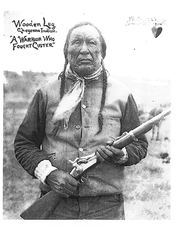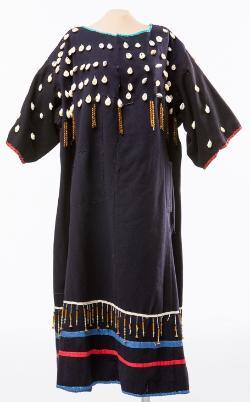Living History: Little Bighorn from a Cheyenne Perspective
The legendary Battle of Little Bighorn was a defining moment for two Native American nations, the Cheyenne and the Lakota Sioux. Cheyenne Chiefs American Horse and Two Moons, and Lakota Chiefs Crazy Horse, Sitting Bull and Gall defeated elements of the U.S. 7th Cavalry, led by Lt. Col. George Armstrong Custer on June 25-26, 1876.

A much celebrated, yet controversial component to the story of the Battle of Little Bighorn is “the battle dress” – a dress made by Cheyenne women from the garments of soldiers who perished there. Since its creation, the dress has traveled many miles, yet little more is known since Cheyenne elders decreed the battle should not be spoken of for 100 years. The battle dress returned to the battlefield June 25, 2016, and Empire State University staff were on hand during this commemorative event, streaming it live for students. These web streams have been preserved as oral history videos. The dress, on loan from the Northwest Museum of Arts and Culture in Spokane, Washington, was exhibited at the museum and visitor center at the Little Bighorn Battlefield National Monument as part of the 140th anniversary of the battle.
About the Course
Living History: Little Bighorn from a Cheyenne Perspective was developed to commemorate the 140th anniversary of the Battle of Little Bighorn and the return of a battle dress to the battlefield. SUNY Empire staff was on hand during this commemorative event, videotaping events, council meetings, and oral history for students.
This is an interdisciplinary course being offered in the September and January terms. It is available to both undergraduate (4 cr.) and graduate (3 cr. – arrange as an independent study with your advisor) level students, as well as non-degree seeking students.
Enrolled students will:
- Take part in an orientation in Indigenous Studies, with a focus on Cheyenne culture.
- Be introduced to historiography and oral history as a lens for examining and remembering Little Bighorn.
- Receive an orientation in archaeological concerns specific to indigenous studies that will frame exploration of the battleground and the importance of material culture such as the dress.
- Hear oral history recordings by Clifford Eaglefeathers and other members of the Cheyenne Nation.
- Come to understand and address the historical trauma and the potential of both museums and artifacts in facilitating a healing process.
- Faculty for the course is Mentor Menoukha Case , who co-convenes the college’s Interdisciplinary Studies area of study. Clifford Eaglefeathers and Rhianna C. Rogers are a co-developers of the course.
Required Materials
- Little Bighorn Remembered: The Untold Indian Story of Custer's Last Stand, Herman J. Viola, Crown 1999
- Cheyenne Memories of the Custer Fight: A Source Book, Richard Hardorff, Arthur H. Clark 1995
- Content Guides, Readings, and Viewings embedded in course.
*Graduate students will be expected to discuss commodification of indigenous knowledge and address the question: Who interprets Cheyenne history and culture and by what authority do they do so? With this question in mind, students will be expected to critically analyze and exchange scholarly information on holistic, theoretical, and practical issues related to the interpretations of the Battle of Little Bighorn.
Watch an interview with faculty member and member of the Northern Cheyenne tribe, Clifford Eaglefeathers:
About the Battle at Little Bighorn

For many years after its conclusion, the battle was referred to as Custer’s Last Stand. Custer and his troops were enforcing a presidential ultimatum, which was ignored by off-reservation Cheyenne and Sioux roaming in the unceded territory. The Native American nations were defending their way of life. Brig. Gen. Alfred Terry ordered Custer down Rosebud Creek. By the time they were located by Custer, the Lakota Sioux and Cheyenne were trespassing on the land of the Crow Nation, their enemies.

In all, the U.S. broke more than 40 treaties with Native American nations. After the Battle of Washita River in Oklahoma in 1868, Long Hair (Custer) claimed he would never again attack the Cheyenne. After they smoked together to seal the promise, Stone Forehead, a Cheyenne chief and keeper of the medicine arrows, "loosened the ashes in the pipe bowl and poured them out on the toes of Long Hair's boots. As he did so he declared, "Thus will Maheo destroy the soldier chief if he ever walks contrary to the peace pipe again." Stone Forehead added, "If you are acting treacherously towards us, sometime you and your whole command will be killed "(Powell, People of the Sacred Mountain, 710, 719).
Although the elements of 7th Cavalry were defeated at Little Bighorn in 1876, and Custer was killed, the victory proved short-lived for the Native Americans. While some remained in the unceded territory, many others either followed Sitting Bull into Canada or returned to the Great Sioux Reservation in South Dakota.
Responding in part to growing interest in a balanced, unvarnished view of American history, and the fact that in our diverse society, indigenous peoples played a historically unsung role, SUNY Empire State College will examine the Battle of Little Bighorn, acknowledging the contributions of indigenous peoples to our understanding of American history.
The dress, on loan from the Northwest Museum of Arts and Culture in Spokane, Washington, was exhibited at the museum and visitor center at the Little Bighorn Battlefield National Monument as part of the 140th anniversary of the battle.